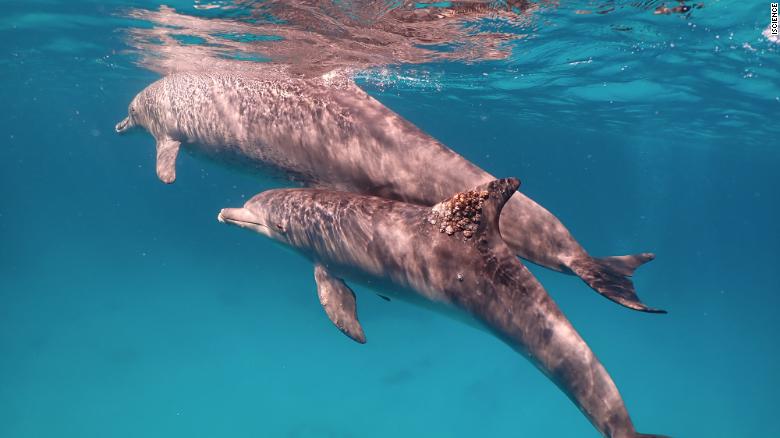Cnn: By Katie Hunt, CNN
Updated 12:28 PM ET, Thu May 19, 2022

By Katie Hunt, CNN
Updated 12:28 PM ET, Thu May 19, 2022
https://www.cnn.com/2022/05/19/world/dolphins-rubbing-coral-medicine-scn/index.html

A dolphin with a fungal infection on its dorsal fin. Rubbing against certain corals may protect dolphins against skin complaints.
Sign up for CNN's Wonder Theory science newsletter. Explore the universe with news on fascinating discoveries, scientific advancements and more.
(CNN)In the Red Sea off the coast of Egypt, bottlenose dolphins were spotted in 2009 doing something unusual. They lined up to rub their bodies against coral.
They were choosy about which type of corals they rubbed against, noticed wildlife biologist Angela Ziltener, a guest researcher at the University of Zurich who spent the next 13 years trying to unravel the perplexing behavior.
The results of her extensive research on the community of 360 dolphins were published on Thursday.
By observing the dolphins and studying the properties of the coral, Ziltener and her colleagues discovered that the dolphins appear to use the reef as a medicine chest: Bioactive compounds in mucus released by two different types of coral and a sea sponge likely help the dolphins protect their skin. It's the first time this type of behavior has been witnessed in cetaceans -- the scientific order of marine mammals that includes dolphins, whales and porpoises -- the study said. However, some birds, mammals, insects and reptiles have previously been observed using plant parts or other substances to combat pathogens or parasites.
Building trust
It took Ziltener years of scuba diving with the local dolphin population to earn their trust. "You have to be kind of adopted by the dolphins. It took time to actually see all their secrets," she said.
The dolphins only rubbed against a gorgonian coral known as Rumphella aggregata, the leather coral Sarcophyton sp., and the sea sponge Ircinia sp., Ziltener observed. What's more, they used the organisms in different ways.
With the leather corals and sponges -- which are more compact and harder in texture than the soft gorgonian coral branches -- the dolphins tended to push an isolated body part in and twist it around, the study found. In contrast, they slid their entire bodies into the gorgonian coral several times, rubbing multiple body parts at once.
The dolphin behavior of rubbing against the gorgonian coral, dubbed gorgoning, and Ziltener's research were first revealed in 2017 in the BBC documentary "Blue Planet II" and a number of other nature documentaries. However, this is the first time a detailed study of the behavior has been published in a scientific journal.
When in groups, the dolphins often lined up and took turns rubbing against the gorgonian coral. Interacting with the leather coral didn't appear to be a group activity.
With leather coral, a dolphin would sometimes uproot it from the ground and carry it in its mouth for a few minutes, swinging it around -- an action that caused the compounds to leak out of the coral and spread around the dolphin's head, staining it yellow and green.
Coral samples
Because the reef is protected, the team obtained permission to take small samples -- just a centimeter -- of the corals and sea sponge used by the dolphins. The study analysis found that these organisms contained 17 bioactive compounds, with different properties, such as antibacterial, antioxidative or hormonal attributes, said coauthor Gertrud Morlock, an analytical chemist and professor of food science at Justus Liebig University Giessen in Germany.
The three different organisms showed similar, and some different, effects, Morlock said.
"In common was that all three had a wealth of antibacterial and antimicrobial activities. And what was special for the leather corral, for example, it contained estrogen-like compounds while not the other two."
"We were surprised to find that there were so many (compounds)," she said. "We think (the dolphins) very clearly select these substrates, and we have proven they have bioactive compounds and when they rub on this (the coral), their skin is in direct contact with these molecules."
Skin treatment
The purpose of the behavior is likely to regulate and protect the skin's microbiome -- a bit like how humans might use a skin cream, Morlock explained. She said that the research team didn't have definitive proof that the dolphins were using the coral as a form of medicine, although dolphins do regularly suffer from fungal infections and skin rashes.
Not every dolphin in the pod rubs against coral. Young calves under 1 year old just watch, Ziltener said. This led the researchers to believe the behavior is learned rather than innate.
"Initially, this behavior could have arisen as a result of a drive or instinct, or just merely by chance. Perhaps, a dolphin with irritated skin rubbed along a random coral that released skin-healing chemicals. The relieved dolphin remembered the behaviors and repeated them, then taught those behaviors to others, as in the case of the Australian bottlenose sponge-wearing population," said Diana Barrett, a lecturer in the department of biology at the University of Massachusetts Dartmouth, who was not involved in the research.
"This ability to remember the behaviors and their resultant effects, and then repeat those behaviors to treat future skin problems adds (to) the wealth of evidence that dolphins are intelligent," she said.
Dolphins have long been viewed as highly intelligent animals that are able to communicate and use tools, such as shells, to help them hunt. Ziltener said it's possible that other marine animals might use corals in this way, but it's difficult to observe underwater animals systemically.
Ziltener said the dolphins often wake from naps to perform the coral rubbing behavior.
"It's almost like they are showering, cleaning themselves before they go to sleep or get up for the day," she said.
#cnndolphinmedicine#fineartmagazine#dolfinartfun



No comments:
Post a Comment
Note: Only a member of this blog may post a comment.